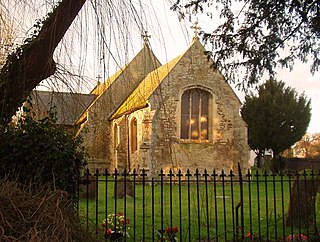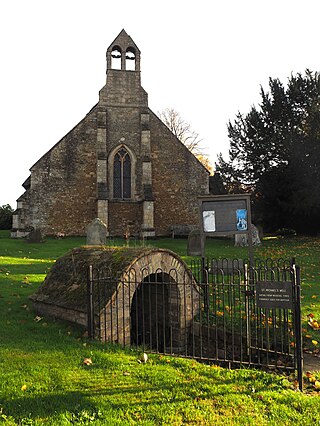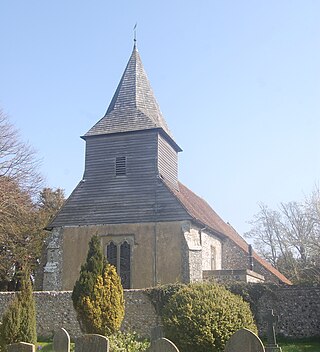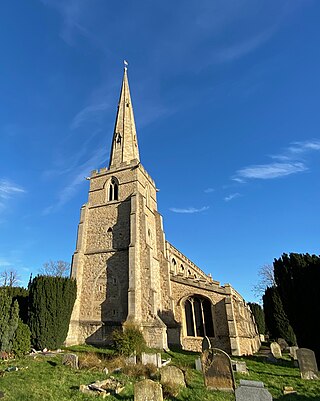
Avebury is a village and civil parish in Wiltshire, England. The village is about 5.5 miles (9 km) west of Marlborough and 8 miles (13 km) northeast of Devizes. Much of the village is encircled by the prehistoric monument complex also known as Avebury. The parish also includes the small villages of Avebury Trusloe and Beckhampton, and the hamlet of West Kennett.

Denny Abbey is a former abbey near Waterbeach, about 6 miles (10 km) north of Cambridge in Cambridgeshire, England. It is now the Farmland Museum and Denny Abbey.

Isleham is a village and civil parish in the English county of Cambridgeshire. It is part of the Fens. It has three pubs.

Fordham is a village in rural Cambridgeshire, England. Fordham is part of the East Cambridgeshire district. It is four miles north of Newmarket, as well as being close to the settlements of Soham, Burwell, Isleham, Mildenhall and Chippenham.
Great Raveley and Little Raveley are villages near Upwood south of Ramsey. They are located in Huntingdonshire, England, 3½ miles south-west of Ramsey. The population is shown in the civil parish of Upwood and the Raveleys.

Lancaster Priory, formally the Priory Church of St Mary, is the Church of England parish church of the city of Lancaster, Lancashire, England. It is located near Lancaster Castle and since 1953 has been designated a Grade I listed building. It is in the deanery of Lancaster, the archdeaconry of Lancaster and the Diocese of Blackburn. Its benefice is combined with that of St John and St Anne.

St George's Church, Little Thetford, is an Anglican church in the village of Little Thetford, Cambridgeshire, England.
Eye Priory was a Benedictine Priory dedicated to St Peter in the town of Eye in the English county of Suffolk. It was founded by Robert Malet c. 1080 and originally an Alien Priory dependent on Bernay Abbey in Normandy. It became independent in 1385 by charter of Richard II when it could support only 3-4 monks. It was finally dissolved in 1537 as part of the Dissolution of the Monasteries, with the lands being given to Charles Brandon, 1st Duke of Suffolk.

St John's Church is a redundant Anglican church in the village of Duxford, Cambridgeshire, England. In 1967 it was recorded in the National Heritage List for England as a designated Grade I listed building, and is now vested in The Churches Conservation Trust. The church stands on the junction of St John's Street and Green Street and is open daily to visitors.

St Michael's Church is a redundant Anglican church in the village of Longstanton, Cambridgeshire, England. It is recorded in the National Heritage List for England as a designated Grade II* listed building, and is under the care of the Churches Conservation Trust. The church stands at the south end of the village. The design of St Michael's was used for that of the Church of St. James the Less in Philadelphia, Pennsylvania, as well as St. Thomas Church in New Windsor, New York, both in 1846. It has been influential in the design of other churches in the American Gothic Revival style.

Woolstone is a village and civil parish about 4+1⁄2 miles (7 km) south of Faringdon in the Vale of White Horse. Woolstone was part of Berkshire until the 1974 boundary changes transferred it to Oxfordshire. The 2011 Census recorded the parish population as 210.

St Margaret's Church is a historic Anglican church in the village of Abbotsley, Cambridgeshire, England. It is recorded in the National Heritage List for England as a designated Grade II* listed building, and is under the care of The Churches Conservation Trust. The church stands in the centre of the village, to the south of the B1046 road.

The Church of St Thomas the Martyr is in School Lane, Up Holland, Lancashire, England. It is an active Anglican parish church in the deanery of Ormskirk, the archdeaconry of Warrington, and the diocese of Liverpool. The church is recorded in the National Heritage List for England as a designated Grade I listed building.

St Mary and St Peter's Church is in the village of Wilmington, East Sussex, England. It is an active Anglican parish church on the deanery of Lewes and Seaford, the archdeaconry of Lewes and Hastings, and the diocese of Chichester. Founded in the late 11th century to serve villagers in a rural area at the foot of the South Downs, it also functioned as a priory church for the monks from the adjacent Wilmington Priory, to which it was physically connected. The building has "benefited from sympathetic restoration" over the centuries—including a series of works by prominent architects Paley and Austin in the Victorian era, and internal renovation after a fire in the early 21st century. The church is recorded in the National Heritage List for England as a designated Grade I listed building.

St Giles' Church is in the hamlet of Barrow, Shropshire, England. It is an active Anglican parish church in the deanery of Telford Severn Gorge, the archdeaconry of Ludlow, and the diocese of Hereford. Its benefice is united with those of All Saints, Broseley, St Mary, Jackfield, St Bartholomew, Benthall, and St Leonard, Linley. The church is recorded in the National Heritage List for England as a designated Grade I listed building. It is one of the earliest surviving churches in Shropshire, and contains the county's only Anglo-Saxon chancel.

Holy Trinity Church, Micklegate, York is a Grade I listed parish church in the Church of England in York.

The Church of St Margaret of Antioch is the Anglican parish church for the village of Bygrave in Hertfordshire. Dedicated to St Margaret of Antioch, the church has been a Grade II* listed building since 1968 and comes under the Diocese of St Albans.

The Church of St Mary the Virgin in Pilton is the 13th-century Anglican parish church for the Pilton suburb of Barnstaple in Devon. It has been a Grade I listed building since 1951 and comes under the Diocese of Exeter.

St Andrew's Church, Chesterton is a Church of England parish church in Chesterton, Cambridge. It is a Grade I listed building. A church was first recorded on this site around 1200. The church was presented in 1217 to the papal legate, Cardinal Guala, by Henry III of England, in gratitude for the legate's attempt at reconciliation during domestic unrest at the end of the reign of King John. In 1436 Henry VI seized ownership of the church and associated buildings from the Italian Abbey of Vercelli and gave it to King's Hall, Cambridge which later became Trinity College, Cambridge. Trinity College is the church's patron to this day; with many vicars of Chesterton being fellows of Trinity.
There are 287 scheduled monuments in the county of Cambridgeshire in the East of England. These protected sites date from the Neolithic period in some cases and include barrows, churches, castle earthworks, Roman roads, moated sites and medieval priories. In the United Kingdom, the scheduling of monuments was first initiated to ensure the preservation of "nationally important" archaeological sites or historic buildings. Protection is given to scheduled monuments under the Ancient Monuments and Archaeological Areas Act 1979.

















